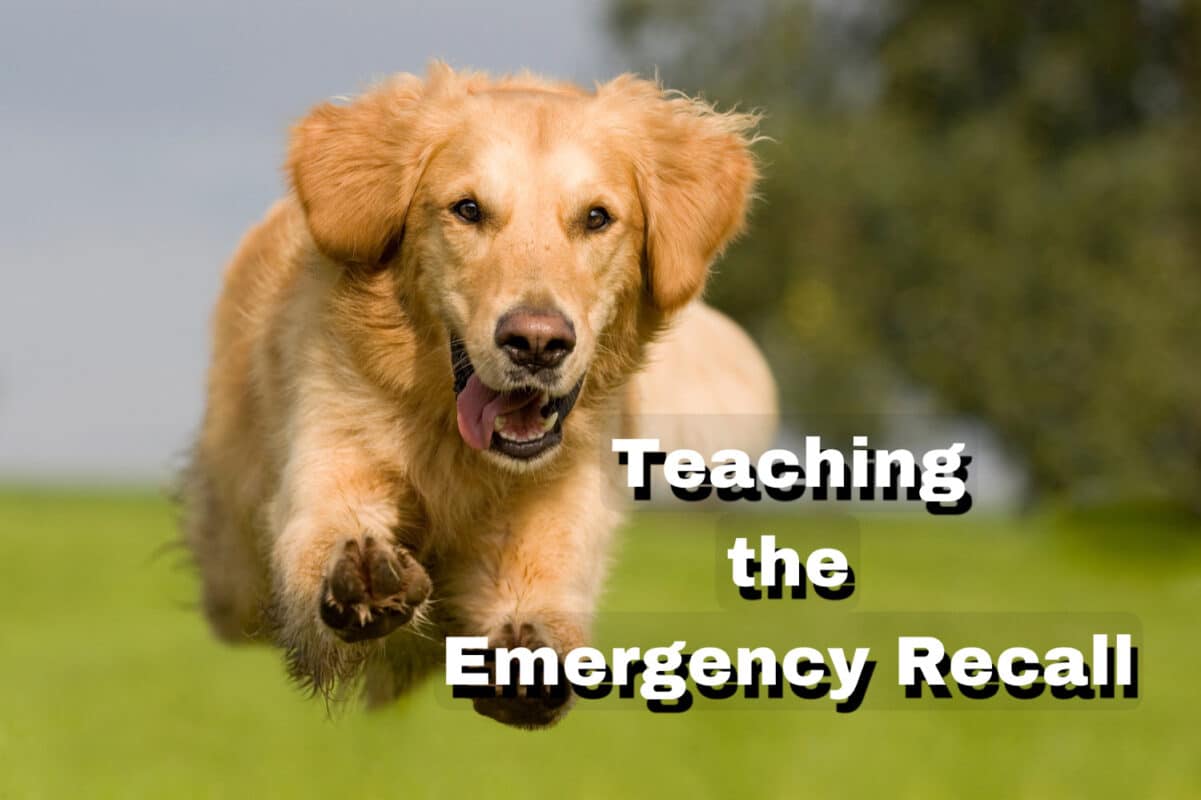Emergency Recall
Teaching and Implementing an Effective Emergency Recall for Your Dog
By Will Bangura, M.S., CBCC-KA, CPDT-KA, FFCP, (Dog Behaviorist,) Certified Dog Behavior Consultant
Introduction
Training a dog encompasses myriad techniques, methodologies, and commands, each essential to molding a well-behaved, obedient, and safe canine companion. One command of paramount importance in this training regimen is the ’emergency recall.’ Unlike the everyday recall or ‘come’ command, an emergency recall is a distinctive directive used exclusively in potentially dangerous situations where the dog’s immediate return is vital. This command acts as a lifeline, potentially saving a dog from a dangerous, or even life-threatening situation (APDT, 2020).
Delving into the Concept of Emergency Recall
At its core, an emergency recall is a command designed to ensure a dog’s safety in potentially hazardous scenarios. Whether faced with the threat of an aggressive animal, the potential danger of darting onto a bustling road, or another environmental hazard, an effectively trained emergency recall can serve as a dog’s literal savior (Dunbar, 2018).
Beyond serving a safety role, the emergency recall carries deeper implications. Successful implementation of the emergency recall can foster significant improvement in a dog’s discipline, focus, and overall bond shared with their handler. The command’s high-stakes nature and consistent high-value reward association make it a unique aspect of the dog’s training, helping to develop trust and a strong bond between the handler and the dog (Schalke, Stichnoth, & Jones-Baade, 2007).
Notably, a dog’s interpretation of an emergency recall differs significantly from that of regular commands. Typically associated with distinct signals and high-value rewards, an emergency recall is prioritized over routine commands due to the dog’s associative learning process. This distinction stems from consistent, rewarding training that accentuates the command’s high importance (Schalke et al., 2007).
Preparing for Emergency Recall Training
Before embarking on the journey of teaching your dog an emergency recall, certain prerequisites can set the stage for more effective training. First, the selection of an ideal training environment is key. This environment should be devoid of distractions to allow your dog to concentrate wholly on the task at hand. For instance, starting the training process in a quiet room in your house can provide a conducive learning environment (McConnell, 2008).
Next, choosing a unique and distinctive command or signal for the emergency recall is crucial. This cue should be different from everyday commands to eliminate confusion and underscore the command’s importance. The goal is to create a specific association in the dog’s mind, linking the unique command to the emergency recall (Zak, 2016).
Lastly, an emergency recall command must have an exclusive, high-value reward system. Unlike regular commands that might be rewarded with a pat or verbal praise, an emergency recall should be linked to a reward that your dog highly values, such as a favorite treat or toy. This reward system is designed to make responding to the command a highly rewarding experience for the dog, motivating them to obey consistently (Donaldson, 2007).
A Detailed Guide to Training Your Dog in Emergency Recall
Training a dog for emergency recall involves a series of progressive steps designed to build your dog’s understanding and response over time. This process is not a quick fix but rather a methodical approach to creating lasting behavioral changes.
Introducing the Emergency Recall:
Initiate the training by standing a short distance from your dog in your chosen distraction-free environment. Clearly give the emergency recall command and observe your dog’s reaction. If your dog correctly responds by coming to you, immediately give them the designated high-value reward. Repeat this process multiple times to forge a strong association between the command, the desired action (coming to you), and the rewarding outcome (Reid, 1996).
Gradually Increasing the Distance:
As your dog begins to grasp the emergency recall command in close proximity, it’s time to gradually increase your distance from them during training. This incremental approach to distance ensures your dog adapts to respond to the command from further away while keeping the association with the action and the reward intact (Reid, 1996).
Introducing Distractions: With your dog consistently responding to the command at different distances, you can start adding distractions to the mix. Begin with mild distractions like someone else being in the room, and then slowly introduce larger distractions. Each time your dog successfully responds to the command despite distractions, provide them with their high-value reward (Donaldson, 2007).
Incorporating Real-World Distractions:
Upon your dog mastering the command amidst controlled distractions, it’s time to expose them to real-world environments. Starting with peaceful outdoor areas like a quiet park or your backyard, you can slowly graduate to busier and more distraction-filled areas. This progression equips your dog to obey the command, irrespective of their surroundings or the distractions present (Pryor, 1999).
Advanced Techniques in Emergency Recall Training
Emergency recall training can incorporate a variety of advanced techniques and strategies that further enhance its effectiveness and reliability.
Safety Measures:
During the initial stages of training, a long line connected to your dog’s harness can serve as an effective safety measure. The line provides physical control over your dog while giving them the illusion of being off-leash. This approach helps prevent the dog from running into potentially dangerous situations during the learning process (Fisher, 2009).
Variable Rewards: Variable rewards can boost the effectiveness of training by stimulating the dog’s interest and anticipation. This strategy involves varying the type or size of rewards, which keeps the dog guessing and engaged, ultimately making the recall more effective (Scholz & Bonanni, 2017).
Emergency Stop:
An advanced extension of the emergency recall is the emergency stop command. This command instructs the dog to immediately halt and lie down rather than return to the handler. It can be particularly useful in situations where staying in place is safer than the dog returning to you (Fennell, 1996).
Troubleshooting Common Challenges in Emergency Recall Training
Training your dog in the emergency recall may come with its share of challenges. However, understanding these potential obstacles and how to overcome them can lead to more successful training.
Inconsistent Responses:
One common challenge is a lack of consistency in your dog’s response to the command. This inconsistency can often be attributed to confusion or a lack of understanding. In such cases, revisiting the basics and ensuring your dog is amply rewarded for each successful recall can reinforce the desired behavior (Pryor, 1999).
The Poisoned Cue:
Another frequent issue is the ‘poisoned’ cue, where a command has been used so often without reward or under negative circumstances that the dog learns to ignore it. To prevent this, use the emergency recall command exclusively for training or actual emergencies, always following it with a high-value reward (Donaldson, 2007).
Successful emergency recall training lies in consistent reinforcement and ‘proofing’ the behavior under various conditions. ‘Proofing’ involves practicing the command in different environments and amid varying levels of distractions. This technique ensures your dog will respond to the command regardless of their surroundings (Meyer, 2010).
Conclusion
The journey of training a dog for an emergency recall is not a sprint but a marathon. It’s a commitment requiring patience, understanding, and a deep insight into your dog’s learning processes. The rewards, however, are well worth the effort. A well-executed emergency recall can ensure peace of mind and, more importantly, keep your dog safe in potentially dangerous situations. Like any significant behavioral modification, consistency, practice, and reinforcement are the cornerstones of a successful emergency recall training process (McConnell, 2008).
Beyond the tangible benefits of ensuring your dog’s safety, emergency recall training can greatly enhance the bond between handler and dog. It creates a unique form of communication, one that highlights trust, understanding, and cooperation. The result is a deeper, more meaningful connection with your canine companion, borne out of shared experiences and mutual trust (Ryan, 2010).
Lastly, it’s important to remember that training a dog, like any form of education, is an ongoing process. There’s always room for improvement, refinement, and adaptation based on your dog’s changing needs and behavior. An effectively trained emergency recall is not a static command but a dynamic aspect of your dog’s repertoire, evolving with time and experience. A mindful approach to training, coupled with a love for your canine companion, will ensure that the emergency recall serves its purpose – keeping your dog safe and strengthening your bond with them (Pryor, 1999).
References
- APDT (2020). Dog training basics. Association of Professional Dog Trainers.
- Donaldson, J. (2007). Oh Behave! Dogs from Pavlov to Premack to Pinker. Dogwise Publishing.
- Dunbar, I. (2018). Before and After Getting Your Puppy: The Positive Approach to Raising a Happy, Healthy, and Well-Behaved Dog. New World Library.
- Fennell, J. (1996). The Dog Listener: Learning the Language of Your Best Friend. HarperCollins.
- Fisher, J. (2009). Think Dog: The Bestselling Guide to Canine Psychology. Cassell Illustrated.
- McConnell, P. (2008). Family Friendly Dog Training: A Six-Week Program for You and Your Dog. McConnell Publishing.
- Meyer, A. (2010). Happy Dog: Caring For Your Dog’s Body, Mind and Spirit. Random House.
- Pryor, K. (1999). Don’t Shoot the Dog: The Art of Teaching and Training. Ringpress Books.
- Reid, P. (1996). Excel-erated Learning: Explaining in Plain English How Dogs Learn and How Best to Teach Them. James & Kenneth Publishers.
- Ryan, T. (2010). The Toolbox for Building a Great Family Dog. Dogwise Publishing.
- Schalke, E., Stichnoth, J., & Jones-Baade, R. (2007). Stress symptoms caused by the use of electric training collars on dogs (Canis familiaris) in everyday life situations. Current Issues and Research in Veterinary Behavioral Medicine.
- Scholz, M., & Bonanni, R. (2017). The Companion Dog: Anthropological Perspectives. Cambridge Scholars Publishing.
- Zak, V. (2016). The Secret Language of Dogs: Unlocking the Canine Mind for a Happier Pet. Houghton Mifflin Harcourt.


